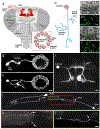Structural aspects of the aging invertebrate brain
- PMID: 33409654
- PMCID: PMC7965346
- DOI: 10.1007/s00441-020-03314-6
Structural aspects of the aging invertebrate brain
Abstract
Aging is characterized by a decline in neuronal function in all animal species investigated so far. Functional changes are accompanied by and may be in part caused by, structurally visible degenerative changes in neurons. In the mammalian brain, normal aging shows abnormalities in dendrites and axons, as well as ultrastructural changes in synapses, rather than global neuron loss. The analysis of the structural features of aging neurons, as well as their causal link to molecular mechanisms on the one hand, and the functional decline on the other hand is crucial in order to understand the aging process in the brain. Invertebrate model organisms like Drosophila and C. elegans offer the opportunity to apply a forward genetic approach to the analysis of aging. In the present review, we aim to summarize findings concerning abnormalities in morphology and ultrastructure in invertebrate brains during normal aging and compare them to what is known for the mammalian brain. It becomes clear that despite of their considerably shorter life span, invertebrates display several age-related changes very similar to the mammalian condition, including the retraction of dendritic and axonal branches at specific locations, changes in synaptic density and increased accumulation of presynaptic protein complexes. We anticipate that continued research efforts in invertebrate systems will significantly contribute to reveal (and possibly manipulate) the molecular/cellular pathways leading to neuronal aging in the mammalian brain.
Keywords: Axons; Dendrites; Invertebrates; Neurons; Normal aging; Synapses.
Conflict of interest statement
Figures



Similar articles
-
Reproductive aging in invertebrate genetic models.Ann N Y Acad Sci. 2010 Aug;1204:149-55. doi: 10.1111/j.1749-6632.2010.05522.x. Ann N Y Acad Sci. 2010. PMID: 20738285 Free PMC article.
-
Polarity and intracellular compartmentalization of Drosophila neurons.Neural Dev. 2007 Apr 30;2:7. doi: 10.1186/1749-8104-2-7. Neural Dev. 2007. PMID: 17470283 Free PMC article.
-
Occurrence and three-dimensional structure of multiple synapses between individual radiatum axons and their target pyramidal cells in hippocampal area CA1.J Neurosci. 1993 Sep;13(9):3736-48. doi: 10.1523/JNEUROSCI.13-09-03736.1993. J Neurosci. 1993. PMID: 8366344 Free PMC article.
-
Genetic analysis of cholinergic nerve terminal function in invertebrates.J Neurocytol. 1996 Dec;25(12):747-62. doi: 10.1007/BF02284839. J Neurocytol. 1996. PMID: 9023722 Review.
-
Cellular and molecular modifier pathways in tauopathies: the big picture from screening invertebrate models.J Neurochem. 2016 Apr;137(1):12-25. doi: 10.1111/jnc.13532. Epub 2016 Feb 11. J Neurochem. 2016. PMID: 26756400 Review.
Cited by
-
Ythdf2 Ablation Protects Aged Retina From RGC Dendrite Shrinking and Visual Decline.Aging Cell. 2025 May 15;24(7):e70107. doi: 10.1111/acel.70107. Online ahead of print. Aging Cell. 2025. PMID: 40371666 Free PMC article.
-
Synaptic Development in Diverse Olfactory Neuron Classes Uses Distinct Temporal and Activity-Related Programs.J Neurosci. 2023 Jan 4;43(1):28-55. doi: 10.1523/JNEUROSCI.0884-22.2022. Epub 2022 Nov 29. J Neurosci. 2023. PMID: 36446587 Free PMC article.
-
The times they are a-changin': a proposal on how brain flexibility goes beyond the obvious to include the concepts of "upward" and "downward" to neuroplasticity.Mol Psychiatry. 2023 Mar;28(3):977-992. doi: 10.1038/s41380-022-01931-x. Epub 2022 Dec 27. Mol Psychiatry. 2023. PMID: 36575306 Free PMC article. Review.
-
Abl depletion via autophagy mediates the beneficial effects of quercetin against Alzheimer pathology across species.Cell Death Discov. 2023 Oct 14;9(1):376. doi: 10.1038/s41420-023-01592-x. Cell Death Discov. 2023. PMID: 37838776 Free PMC article.
-
Reduced neural investment in post-reproductive females of the bee Ceratina calcarta.Sci Rep. 2022 May 18;12(1):8256. doi: 10.1038/s41598-022-12281-7. Sci Rep. 2022. PMID: 35585164 Free PMC article.
References
Publication types
MeSH terms
Grants and funding
LinkOut - more resources
Full Text Sources
Other Literature Sources
Medical
Molecular Biology Databases

